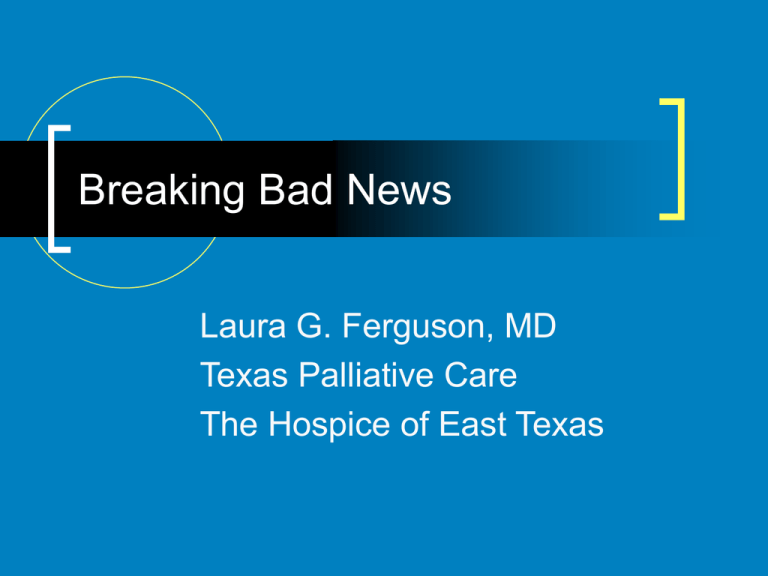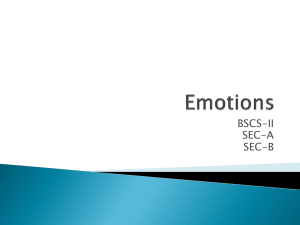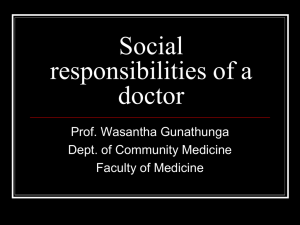Breaking Bad News file
advertisement

Breaking Bad News Laura G. Ferguson, MD Texas Palliative Care The Hospice of East Texas Communication: An expert in breaking bad news is not someone who gets it right every time – he or she is merely someone who gets it wrong less often, and who is less flustered when things do not go smoothly. - R Buckman Objectives: 1. 2. 3. 4. 5. To identify why communication is important To identify obstacles of communication To outline general objectives and techniques of communication in healthcare To address the uniqueness of breaking bad news, while reviewing techniques and approaches to breaking bad news To review good vs bad communication and examples of each Communication Objectives of communication in healthcare: To explain medical conditions and provide essential medical information. To uncover patient and/or family needs, often by engaging in therapeutic dialogue. To discuss goals of care. Communication Patients look to us for knowledge, guidance, reassurance, hope, meaning, and compassion. Patients know we have been through similar situations with other patients and look to us for guidance and what is “normal”. Communication Unfortunately, the quality of communication in healthcare is often suboptimal. Studies show: That discussions of bad news do not meet patient needs and fall short of expert recommendations.(2-4) Patients with cancer tend to disclose fewer than 50% of their concerns(5,6) because of inability to communicate with their physician. Communication Studies Show: The number and severity of unresolved concerns has been shown to predict high emotional distress and future anxiety and depression for patients. (7,8) Physician predictions of their patient’s wishes regarding end of life care and life sustaining treatments were closer to their own choices than based on the patient’s expressed wishes. (9) Communication Studies Show: In one study of 598 oncologists, 56% were burned out and 53% attributed this to the continuous exposure to fatal illness. (10) Communication is therapeutic! Communication “ No news is not good news, it is an invitation to fear.” - CM Fletcher Obstacles to good communication Medical education doesn’t teach communication. Communication involves the psychoemotional and spiritual aspects of care, with training focusing on cognitive teaching. Students are not encouraged to show emotion or feelings. Students lack experience with proper communication and have poor role models. Obstacles to good communication (13,14) Unrealistic expectations of the healthcare system by society. Cultural differences in disclosure of information. Time limitations of medical staff and patients. Lack of trust in the medical system. Lack of experience with death. Obstacles to good communication (13,14) Terminal conditions and dying are difficult subjects to talk about for us and for our patients. Emotions, such as fear: Of the process of dying (symptoms, $ concerns, loss of independence/control, etc). Of blame. Of not having the answers. Of not knowing how to handle emotional outbursts. Obstacles to good communication Other emotions that these conversations can elicit: Stress Sadness Guilt Loss Failure Helplessness Basic Communication Skills Setting Schedule a meeting time. This ensures we allocate time, says to the patient “big news” is coming, and allows family to be present. Have face-to-face communication. >50% of communication is nonverbal. Sit at eye level and within reach of the patient. Minimize distractions. Pager and phone off or on vibrate, door closed, ask colleagues not to disturb you, etc. Basic Communication Skills Information exchange Outline an agenda Why are we meeting and what should be accomplished by the meeting. Ask open ended questions See what they understand. This helps to define a starting point for the conversation. “What do you understand about your condition/diagnosis?” or “What have you been told about your condition?” Basic Communication Skills Information exchange Determine how much information or how many details the patient wants to know. Recognize that the patient and family may be different in their desire of information. “The forest” vs “The trees” Avoid medical jargon or at least define terms. ***Focus should be on the patients’ concerns! Basic Communication Skills LISTEN Basic Communication Skills Responding Address the patients’ concerns. Use nonverbal cues to demonstrate attentiveness. Demonstrate empathy by acknowledging the patients’ feelings as acceptable. Ask about perceived emotions. “You seem angry?” or “I feel you are scared. Do you want to tell me about how you are feeling?” Basic Communication Skills Responding Encourage and justify their emotions. Attend to all issues and needs, including: physical, psychosocial, and spiritual. Review Objectives Summarize Information, discussions, and decisions Key Communication Techniques Ask open-ended questions Use nonverbal cues (nods, “uh-huh”) Provide empathic responses Use repetition Paraphrase Repeats back to the patient what they said. Used to prove listening. Your summary of what the patient said. Used to ensure understanding. Confront emotions…yes, even difficult ones (anger) Summarize Open Ended Questions What do you understand about your condition? What concerns you the most about your illness, your family, your future? How is treatment going for you/your family? What has been most difficult about being ill so far? What are your hopes, fears, or expectations in the future? What matters to you the most? When are your best times? Emotion and Communication Emotion affects processing of information This is an obstacle because most hospitalized patients are in a “bad” mood, which affects how they “hear” the news being given. If the patient and family are angry or too upset, you may not make any decisions on the initial meeting. Responding to Patient Emotions (11) N - Name the emotion. U - Understand/normalize the emotion. R - Respect the patient and family for how they are coping. S - Support the patient so they don’t feel alone. E - Explore the emotion. Communication “Hope is based on knowledge, not ignorance.” “What remains unspoken is unspeakable.” - MA Simpson Breaking Bad News Preparation and Setting The meeting should be in a private place with adequate time. Suggest a supportive person accompany the patient. Have all information and data available. Breaking Bad News Content Determine what the patient knows and wants to know. Get to the point quickly. Fire “warning shots”. “I have bad news.” State the information simply, clearly, and sensitively. Provide information in small chunks. Avoid false reassurance, but don’t be discouraging. Make truthful, honest statements. Breaking Bad News Listen Breaking Bad News Responding to Patient Emotions Be empathetic. NURSE expressed emotions. Explore hope. Explore faith. Be willing to talk about dying. Assure continued support. Offer other resources of support. When communicating with a patient in denial, start as if the patient has had no previous knowledge. Breaking Bad News Empathy: The ability to put aside ones personal agenda and share another being’s emotions, feelings, and perspective. Listening to a patients’ feelings. Expressing you are aware and accepting of a patients’ emotions. End-of-Life Communication Empathetic body language: SOLER Face the patient Squarely Keep Open body position Lean forward Eye contact Maintain a Relaxed and natural posture Hope ≠ Lying We often convey a prognosis with an optimistic bias….is this best? Studies show that the better a doctor knows the patient, the more likely the doctor is to overestimate survival. (16) On average, physicians are wrong > 80% of the time when estimating prognosis. The majority of these inaccuracies are optimistic (~90%). Hope ≠ Lying Focus on hope and what CAN be done. Explore other goals besides cure. “I know you are hoping for a cure, but what other things are you hoping for?” Breaking Bad News Wrap Up Set up a follow-up meeting. Provide written materials as adjuncts or addresses to reliable websites. Offer to talk to relatives/friends. Suggest the patient writes down questions. Keep communication ongoing. Breaking Bad News Three of the greatest challenges with endof-life communication. 1. 2. 3. To remain present when a patients’ suffering evokes our fears and insecurities. To resist the need to do something when listening is more appropriate. Supporting a patients’ decision when it’s not in agreement with what we would recommend. Breaking Bad News Studies Show: Patients prefer to have information about their diagnosis and prognosis, even when the news is worse than expected.” (12) A large, heterogeneous sample of 2331 patients with cancer showed that 2027 (87 per cent) wanted all possible information, be that good or bad news. (15) Breaking Bad News The is no evidence supporting that terminally ill patients who have not been told the truth of their situation die happily in blissful ignorance. Patients witness and experience their deteriorating body. Breaking Bad News Communication is a 2-way street Patients also have to be honest with us regarding their symptoms, preferences, and concerns. Realistic hopes and aspirations can only be generated from honest disclosure. Words Make A Difference Hospice vs. Palliative Care Eating vs. Feeding vs. Artificial Nutrition Understand the difference. Eating is usually done independently with your mouth and feeding is often done by others. Depression vs. Mood Ask about a patients’ mood/spirits. There is a negative stigma associated with depression. Words Make A Difference Resuscitation vs. Natural Decline Pain vs. Suffering “You” want vs. The patients’ wishes Withdrawal care vs. Focus on comfort Words Make a Difference Major discrepancies often exist between what doctors think they said and what the patient actually heard/understood. (18) Example: Doctor: As you know, we recently checked your blood and x-rays so we could start your third cycle of chemotherapy. I reviewed your tests today and there are signs that things are progressing, so we do not think that you should have anymore chemotherapy. Words Make a Difference Patient: Oh! So what happens now? Doctor: Well we just want you to come see us if you develop any further problems, like trouble breathing. Patient: Ok. Well thank you very much doctor. Words Make a Difference Immediately after this consultation the patient is asked what the doctor said. “Well it’s good news really. The doctor says things are progressing so I don’t need anymore chemo and to just come back if my breathing starts up again….getting breathless you know.” Words Make a Difference What could the doctor have said? Doctor: As you know, we recently checked your blood and x-rays so we could start your third cycle of chemotherapy. I reviewed your tests and the cancer is not responding to chemotherapy. We will not do more chemotherapy because it is not helping. We don’t want to put you at risk of side effects when you are not getting any benefit. There are no other curative treatments we can offer you. Your cancer is incurable. Words Make a Difference Patient: Oh! So what happens now? Doctor: Well, we focus on what we can do for you, such as controlling your symptoms. Together we’ll continue to work to keep you feeling and doing as good as you can for as long as you can. LISTEN/RESPOND Doctor: Can you tell me what you understand about our conversation? Do you have any questions? References: 1. 2. 3. 4. 5. 6. 7. 8. 9. 10. 11. 12. Berger AM, Shuster JL, Von Roenn JH. Principles and Practice of Palliative Care and Supportive Oncology . 1998, 527-536. Butow PN, Kazemi JN, et al. When the diagnosis is cancer: patient communication experiences and preferences. Cancer 1996;77(12):2630-2637. Friedrichsen MJ, Strang PM, Carlsson ME. Breaking bad news in the transition from curative to palliative cancer care-patient’s view of the doctor giving the information. Support Care cancer 2000;8(6):472-478. Ptacek JT, Eberhardt TL. Breaking bad news. A review of the literature. JAMA 1996;276(6):496-502. Maguire P. Improving communication with cancer patients. Eur J Cancer 1999;35(10):1415-1422. Heaven CM, Maguire P. Disclosure of concerns by hospice patients and their identification by nurses. Palliat Med 1997;11 (4):284-290. Heaven CM, Maguire P. The relationship between patients’ concerns and psychological distress in a hospice setting. Psychooncology 1998;7(6):502-507. Parle M, Jones B, Maguire P. Maladaptive coping and affective disorders among cancer patients. Psychol Med 1996;26(4):735-744. Nishimura K, Nonomura N, Yasunaga Y, et al. Low doses of oral dexamethasone for hormonerefractory prostate carcinoma. Cancer 2000;89(12):2570-2576. Ahles TA, Herndon JE, Small EJ, et al. Quality of life impact of three different doses of suramin in patients with metastatic hormone-refractory prostate carcinoma: results of Intergroup O159/Cancer and Leukemia Group B 9480. Cancer 2004;101(10):2202-2208. Smith RC, Hoppe RB. The patient’s story: integrating the patient and physician-centered approaches to interviewing. Ann Intern Med 1991;115(6):470-477. Johnston M, Earll L, Mitchell E, Morrison V, Wright S. Communicating the diagnosis of motor neuron disease. Palliat Med. 1996;10:23-34. References: 13. 14. 15. 16. 17. 18. Buckman R. Communication in palliative care: a practical guide. Oxford textbook of Palliative Medicine. 1993:47-61. Buckman R. How to Break Bad News: A Guide for Health Care Professionals. Baltimore, MD: Johns Hopkins University Press; 1992. Jenkins V., Fallowfield L., and Saul J. (2001). Information needs of patients with cancer: results from a large study in UK cancer centers. British Journal of Cancer 84(1),48-51. Christakis NA. Death Foretold. Chicago IL: University of Chicago Press, 1999. Simpson M.A. Therapeutic uses of truth. In The Dying Patient, 1982;255-62. Quirt CF, et al. Do doctors know when their patients don’t? A survey of doctor-patient communication in lung cancer. Lung Cancer 18(1):1-20.







